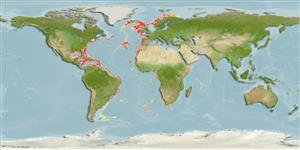>
Stomiiformes (Lightfishes and dragonfishes) >
Phosichthyidae (Lightfishes)
Etymology: thaeocoryla: Named as an anagram of the word 'corythaeloa' - the closest related species in the genus Polymetme (Ref. 41740).
Environment: milieu / climate zone / depth range / distribution range
Ökologie
seewasser bathydemersal; tiefenbereich 213 - 1400 m (Ref. 41740). Deep-water
Eastern Atlantic: along the coasts of Europe and Africa, from Ireland to at least 4°S, also found on the Meteor and Josephine seamounts and off the Canary Islands. Western Atlantic: off Florida, in the Gulf of Mexico, Caribbean, off the coast of Guiana and Suriname, and on the Rio Grande Rise.
Size / Gewicht / Alter
Maturity: Lm ? range ? - ? cm
Max length : 21.6 cm SL Männchen/unbestimmt; (Ref. 41740)
Kurzbeschreibung
Morphologie | Morphometrie
Rückenflossenstacheln (insgesamt): 0; Rückenflossenweichstrahlen (insgesamt): 12-13; Afterflossenstacheln 0; Afterflossenweichstrahlen: 30 - 34; Wirbelzahl: 44 - 45. Pyloric caeca 7-8; photophores above anal fin 17-19 (Ref. 41740).
Life cycle and mating behavior
Geschlechtsreife | Fortpflanzung | Ablaichen | Eier | Fecundity | Larven
Parin, N.V. and O.D. Borodulina, 1990. Review of the genus Polymetme (Phosichthyidae) with the description of two new species. J. Ichthyol. 30(6):108-121. (Ref. 36363)
IUCN Rote Liste Status (Ref. 130435)
Bedrohung für Menschen
Harmless
Nutzung durch Menschen
Mehr Information
NamenSynonymeMetabolismusRäuberÖkotoxikologieFortpflanzungGeschlechtsreifeAblaichenSpawning aggregationFecundityEierEientwicklung
Alter/GrößeWachstumLänge-GewichtLänge-LängeLängenhäufigkeitenMorphometrieMorphologieLarvenLarven Pop.Dyn.RekrutierungDichteBRUVS
ReferenzenAquakulturAquakultur ProfilZuchtlinienGenetikElectrophoresesVererbbarkeitKrankheitenVerarbeitungNutrientsMass conversion
PartnerBilderStamps, Coins Misc.LauteCiguateraGeschwindigkeitSchwimmstilKiemenoberflächeOtolithsGehirngrößeSehfähigkeit
Tools
Zusatzinformationen
Download XML
Internet Quellen
Estimates based on models
Preferred temperature (Ref.
123201): 5.9 - 14.4, mean 9.4 °C (based on 305 cells).
Phylogenetic diversity index (Ref.
82804): PD
50 = 0.5156 [Uniqueness, from 0.5 = low to 2.0 = high].
Bayesian length-weight: a=0.00316 (0.00129 - 0.00773), b=3.18 (2.97 - 3.39), in cm total length, based on LWR estimates for this (Sub)family-body shape (Ref.
93245).
Trophic level (Ref.
69278): 3.5 ±0.5 se; based on size and trophs of closest relatives
Widerstandsfähigkeit (Ref.
120179): mittel, Verdopplung der Population dauert 1,4 - 4,4 Jahre. (Assuming tmax>3).
Fishing Vulnerability (Ref.
59153): Low vulnerability (16 of 100).
Nutrients (Ref.
124155): Calcium = 37.7 [10.0, 151.4] mg/100g; Iron = 0.803 [0.280, 2.094] mg/100g; Protein = 2.18 [0.00, 5.97] %; Omega3 = 0.367 [0.137, 1.048] g/100g; Selenium = 17.4 [4.2, 60.5] μg/100g; VitaminA = 11.1 [2.2, 54.0] μg/100g; Zinc = 0.46 [0.23, 0.92] mg/100g (wet weight);
